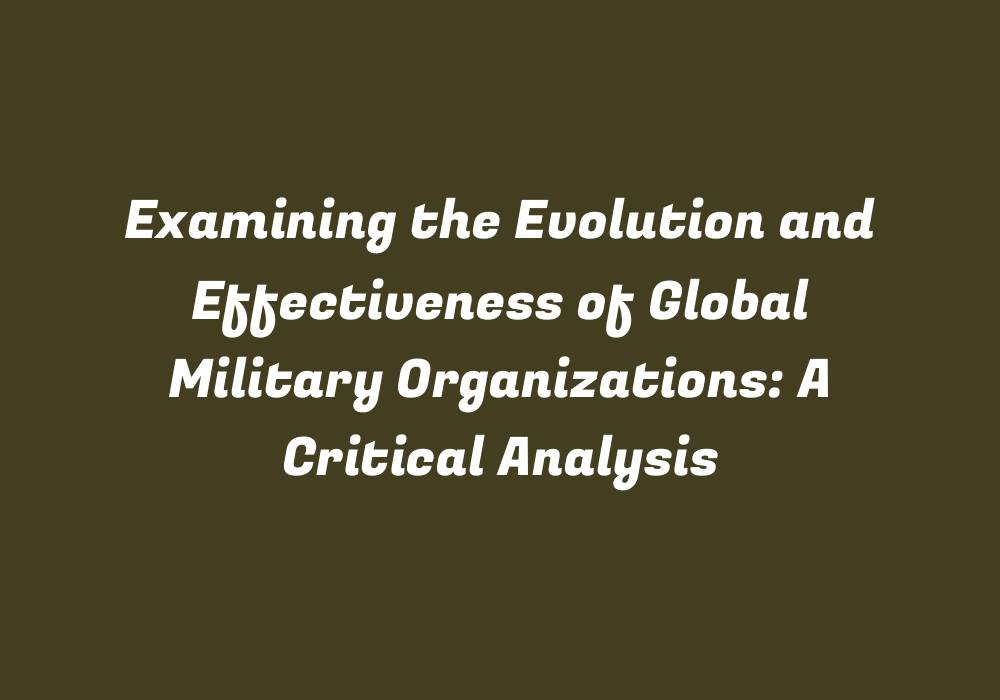Examining the Evolution and Effectiveness of Global Military Organizations: A Critical Analysis
The world has seen a tremendous transformation in military organizations over time. These institutions have evolved to respond to rapidly changing global dynamics, including political and economic upheavals, as well as advancements in technology and strategic threats. In this critical analysis, we will examine the historical background of these organizations, their current structures, and assess their effectiveness in meeting contemporary challenges.
Evolution of Global Military Organizations
The emergence of global military organizations began with the creation of the League of Nations in 1919, following the end of World War I. The organization aimed to provide a platform for international cooperation and collective security. Despite its noble intentions, it failed to prevent the outbreak of World War II and was eventually replaced by the United Nations (UN) in 1945 after the conclusion of the war.
The UN Charter introduced peacekeeping operations, which initially focused on providing military support to civilian populations facing internal conflicts. As these missions evolved, they expanded their scope and became increasingly complex and multidimensional. They now encompass not only humanitarian aid and peacekeeping but also electoral assistance and the protection of civilians from genocide and other crimes against humanity.
Current Structures of Global Military Organizations
There are several key organizations involved in global military operations today, including:
1. The United Nations – As a leading intergovernmental organization, the UN’s role in peacekeeping and humanitarian assistance has grown exponentially over the years. It consists of various subsidiary bodies, such as the Department for Peace Operations (DPO), which oversees peacekeeping missions, and the Office for the Coordination of Humanitarian Affairs (OCHA), responsible for coordinating relief operations.
2. The North Atlantic Treaty Organization (NATO) – Founded in 1949 to provide collective security among European nations against potential Soviet aggression, NATO has since evolved into a global military alliance spanning 30 member countries. Its primary functions include collective defense and crisis management through various joint operations and task forces.
3. The African Union (AU) – As the successor of the Organization of African Unity (OAU), the AU was created in 2001 to promote peace and security on the continent. It has a dedicated military wing, known as the African Standby Force, which is designed to respond rapidly to crises within Africa.
4. The European Union (EU) – As one of the world’s most influential political and economic entities, the EU’s Common Security and Defense Policy (CSDP) seeks to strengthen Europe’s defense capabilities and collaborate on security issues with partner nations outside the continent.
5. The Organization for Security and Co-operation in Europe (OSCE) – Originally established as a forum to facilitate dialogue between East and West during the Cold War, the OSCE has since evolved into an institution that addresses conflict prevention, crisis management, and post-conflict rehabilitation throughout its 57 member states.
6. The World Health Organization (WHO) – As the leading international public health organization, the WHO plays a significant role in responding to epidemics, natural disasters, and other emergencies that have potential security implications.
Effectiveness of Global Military Organizations
While global military organizations have demonstrated their capacity to manage a range of complex crises, there is room for improvement in their effectiveness. Several key areas require further examination:
1. Funding and resource allocation – Adequate funding and strategic resource management are crucial elements for the success of any global military organization. Inadequate resources can hinder mission objectives and lead to operational challenges.
2. Political and diplomatic support – Military organizations often rely on strong political backing from their member states. Effective collaboration requires a clear understanding of each country’s priorities, interests, and limitations in order to avoid misunderstandings or power struggles among actors involved in the decision-making process.
3. Coordination and cooperation – Collaboration between different agencies within global military organizations can be a significant challenge due to varying mandates, operational frameworks, and communication networks. Improved coordination mechanisms should be developed to facilitate smooth collaboration among stakeholders and ensure a unified response during crises.
4. Capacity building – Many global military organizations lack the necessary resources or expertise to address new and emerging threats, such as cyber-attacks, terrorism, and climate change. Enhancing training programs and capacity development initiatives for both civilian and military personnel can help better prepare these institutions to tackle future challenges effectively.
5. Accountability and transparency – As global military organizations continue to expand their operations, concerns over accountability and transparency become increasingly important in terms of ensuring that missions are carried out responsibly and ethically. Better mechanisms must be established to monitor the actions and decision-making processes of these institutions.
In conclusion, global military organizations have transformed considerably since their inception following World War I. Despite the significant progress they have made over time, there is still room for improvement in addressing emerging challenges and enhancing the effectiveness of these critical institutions in promoting peace and security across the globe. By addressing these key areas for further development, these organizations can become more robust and better equipped to meet the diverse demands of an increasingly interconnected world.
